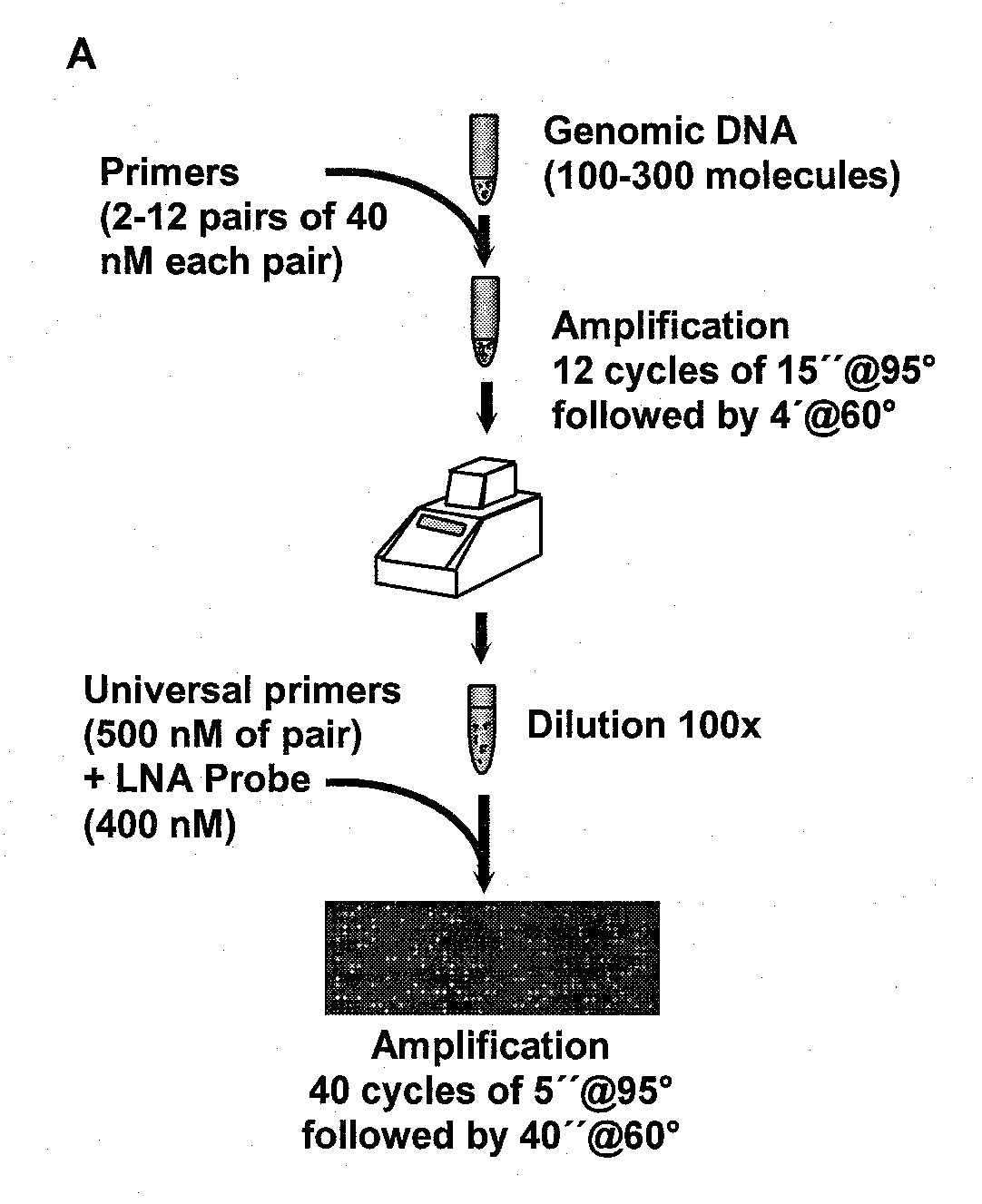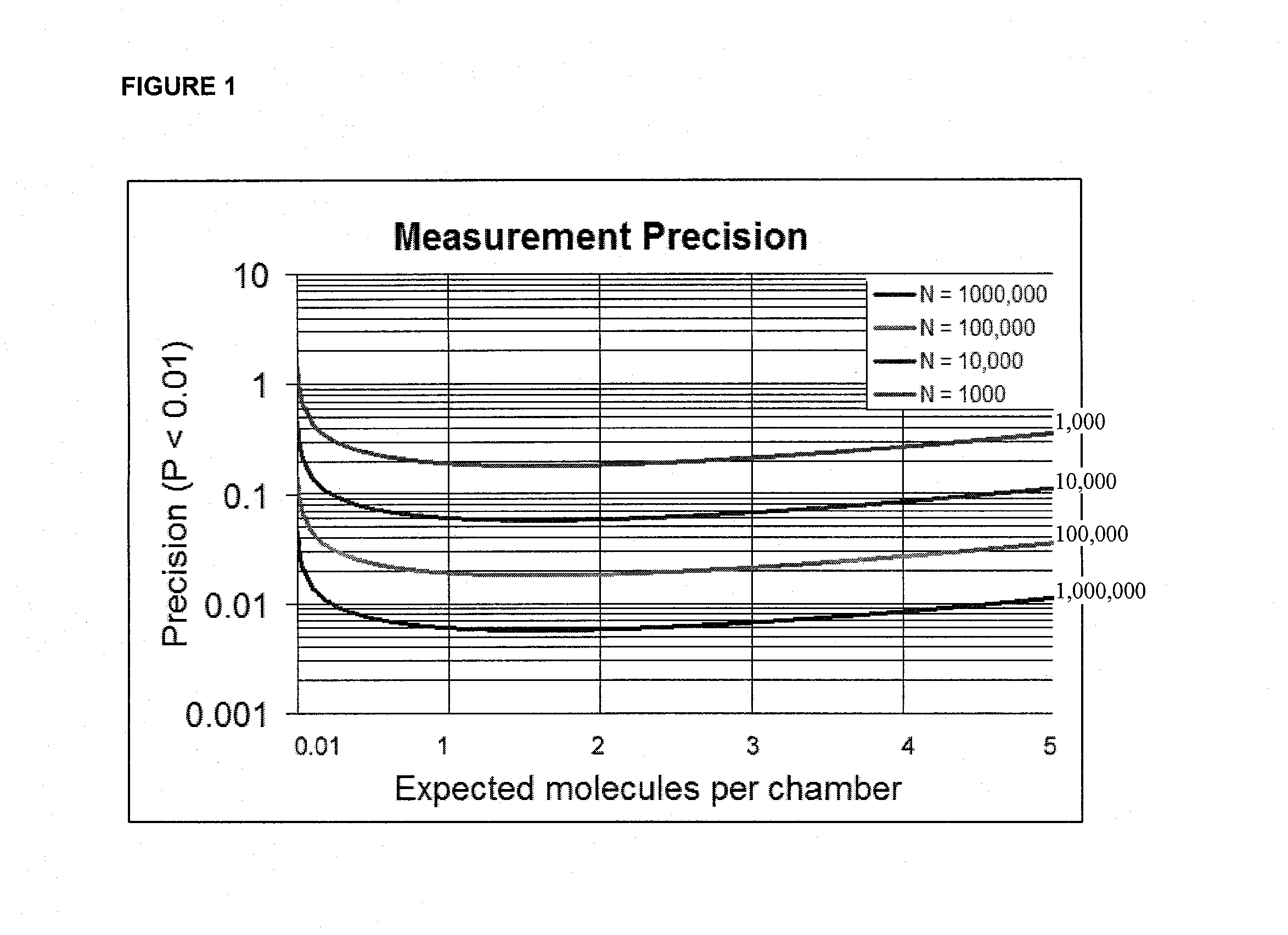Multiplex Amplification for the Detection of Nucleic Acid Variations
a nucleic acid variation and multi-amplification technology, applied in the field of digital amplification methods, can solve the problems of serious pathologies, serious birth defects, and errors in the resulting cell, and achieve the effects of high background noise, high cross-reactivity, and high levels of non-specific amplification
- Summary
- Abstract
- Description
- Claims
- Application Information
AI Technical Summary
Benefits of technology
Problems solved by technology
Method used
Image
Examples
example 1
Calculation of Digital PCR Precision
[0133]The theoretical precision of digital PCR analysis depends on the total number of chambers (N) and the expected number of molecules per chamber (A). In the case of NA >>1 the number of molecules present in each chamber is a random variable k that is well described as an independent Poisson process. The probability of detecting at least one molecule is P(k>0)=1−e−λ. Let x be a random variable describing the number of chambers having at least one molecule in an array of N chambers. P(x) is therefore given by a binomial distribution with mean N(1−e−λ) and variance σ2=N(e−λ−e−2λ). Under the condition of large N this is well approximated as a Gaussian distribution:
P(x)=12πN(-λ--2λ)exp(-(x-N(1--λ))22N(-λ--2λ)
[0134]We define the precision of a digital PCR measurement as the minimum difference in concentration Δλ that can be reliably detected with less than 1% false positive and less than 1% false negative. This corresponds to a 4.6 σ separation in t...
example 2
Calculation of the Separation in the Measured Mean of Two Alleles Varying by 1% Using Digital PCR as a Function of the Number of Discrete Subsamples (for Example, Chambers)
[0138]FIG. 2 shows a numerical calculation of the separation in the measured mean of two alleles varying by 1% using digital PCR as a function of the number of chambers. Difference is normalized by the expected standard deviation (sigma) as determined by the combined effect of 5 stochastic Poisson variation (curved line). The calculation was performed for template concentration corresponding to positive amplification in 50% of wells. 5 sigma separation (horizontal line) is achieved at approximately 1,000,000 chambers. Standard deviation achieved with the number of compartments for the discrimination of 1% difference in DNA concentration at a fill factor of 0.5 in digital PCR experiments.
example 3
Theoretical Calculations of Sample Molecule Content and Blood Sample Volume
[0139]Fetal DNA is reported to occur in maternal blood and represents approximately 2 to 6 percent of the total DNA present in the cell-free serum during the first trimester (Lo et al. 1997; Lo et al. 1998; Wachtel et al. 2001; Lee et al. 2002). However, later publications have suggested that the fetal contribution may be 9.7%, 9.0%, and 20.4% for the first, second, and third trimesters, respectively (Lun et al. 2008). For example, each genome copy of the T21 fraction contributes an extra copy of chromosome 21, which allows for a direct non-invasive maternal blood test by measuring the ratio of chromosome copy numbers present in maternal serum. If we assume a 2% fraction of fetal DNA in a maternal blood sample, the expected enrichment of chromosome 21 with respect to the other chromosomes in the pool is (0.02×1) / (1×2)=1%. Such a small difference in relative concentrations is undetectable by qRT-PCR which can ...
PUM
| Property | Measurement | Unit |
|---|---|---|
| Digital information | aaaaa | aaaaa |
| Volume | aaaaa | aaaaa |
| Volume | aaaaa | aaaaa |
Abstract
Description
Claims
Application Information
 Login to View More
Login to View More - R&D
- Intellectual Property
- Life Sciences
- Materials
- Tech Scout
- Unparalleled Data Quality
- Higher Quality Content
- 60% Fewer Hallucinations
Browse by: Latest US Patents, China's latest patents, Technical Efficacy Thesaurus, Application Domain, Technology Topic, Popular Technical Reports.
© 2025 PatSnap. All rights reserved.Legal|Privacy policy|Modern Slavery Act Transparency Statement|Sitemap|About US| Contact US: help@patsnap.com



